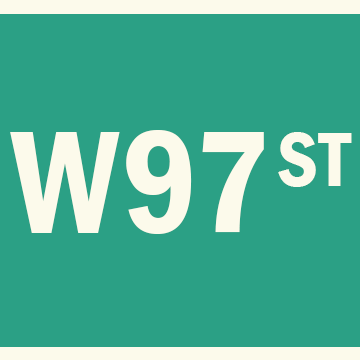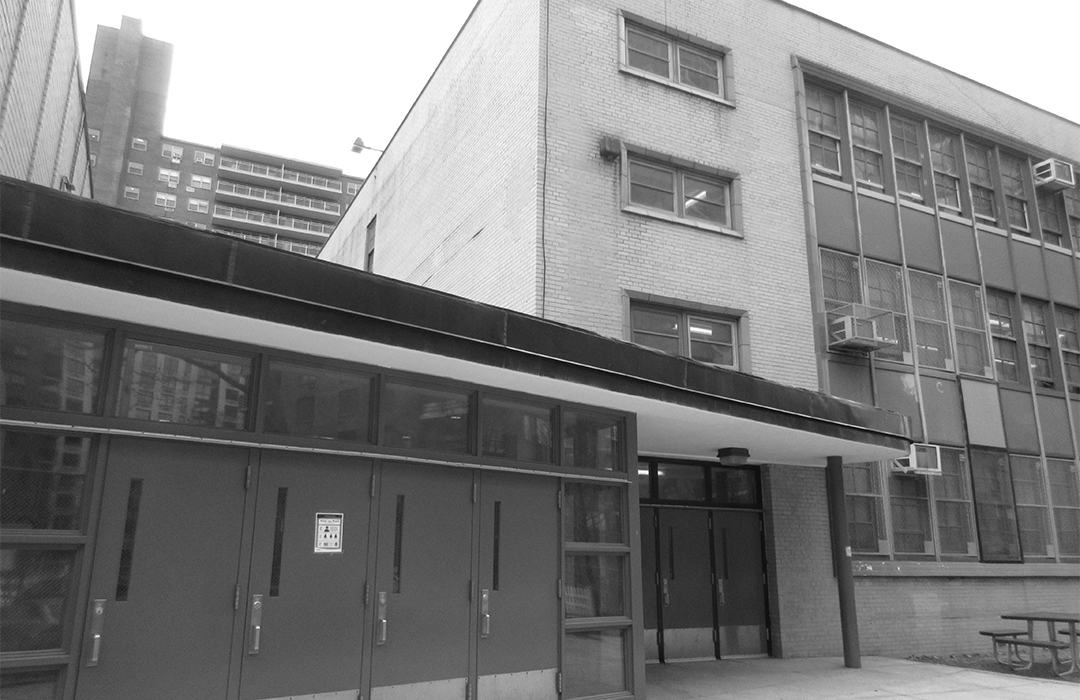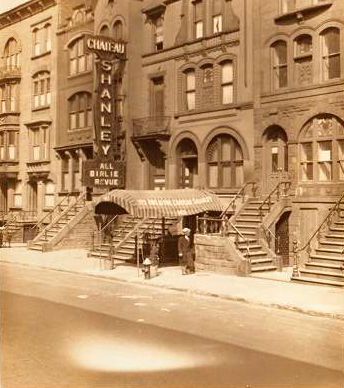PS 163

PS 163, 163 West 97th Street
by Tom Miller
Singer Will H. Oakland was, according to The New York Times, “the idol of the ‘bobby soxers’ of his day.” Oakland’s “day” was the 1920s. With the money he made in his singing career, he opened several nightclubs in the metropolitan area, including the Chateau Shanley at 163 West 97th Street. Along with dinner, patrons could enjoy an “All Girlie Revue.”
But the city embarked on a slum-clearing effort in the neighborhood at mid-century, and in 1956 (coincidentally the same year Will Oakland died), the block of brownstones that included 163 West 97th Street was razed. On the site where the nightclub had stood, architect Michael L. Radoslovich designed Public School 163 for the Department of Education.
Construction began in 1957 and was completed the following year. Radoslovich’s low-rise, minimalist design featured a long, low-slung single-story wing with a continuous run of openings. Its green-hued brick contrasted with the beige brick of the slightly taller section to the west, and the three-story segment to the north. Taken as a whole, the sleek configuration gave the impression of stepped mesas.
Also called the Alfred E. Smith School, its students were diverse, including a significant percentage of Black and Hispanic students. It was not race, but politics, however, that brought attention to the school in 1960. On January 3, the New York Post reported, “Four more teachers are being suspended without pay for allegedly falsifying applications for licenses with respect to Communist Party membership, Schools Supt. Theobald announced today.” Among those educators was Samuel S. Cohen, the principal of PS 163.
Taken as a whole, the sleek configuration gave the impression of stepped mesas.
Racial tensions boiled over on the Upper West Side in 1963 when a policeman from the West 100th Street stationhouse shot and killed two Puerto Ricans in a patrol car. The New York Times commented, “The station became a focal point for hatred of the police in the precinct.” Hoping to improve relations, on December 19, 1964, the precinct held a Christmas party in the gymnasium of PS 163. The New York Times reported, “The children watched movie cartoons, laughed at ‘Joe Madden, the free‐lance clown,’ applauded a Spanish dancer and collected gifts of games and candy bought with $200 collected in a local fund drive.”
Diversity was necessarily important in the activities and programs at PS 163. On December 14, 1965, for instance, the New York World-Telegram reported, “A special program of African dance, music and song was held at an assembly in PS 163, Manhattan.”
Included in the building was the Alfred E. Smith Community Center, a vital meeting place for the district. On April 3, 1968, the Middle Income Residents Association (MIRA) held an important meeting here, during which Assemblyman Benjamin Altman described bills currently before the State legislature that would directly affect middle-income families. Representatives of 18 different tenant groups from the Bronx, Manhattan, and Brooklyn were in attendance.
The space was also used for the regular meetings of Community Board District 3, and for other public service purposes. On March 26, 1971, according to the Amsterdam News, the film Naissance, was screened. The article explained that the film, produced in France, “depicts training classes for expectant parents, explains the Lamaze method of childbirth, and concludes with the delivery of a child to his fully awake and aware mother with the baby’s father in attendance in the delivery room.” It and a follow-up film, The New Generation, were sponsored by the American Society for Psychoprophylaxis in Obstetrics.
Perhaps unexpectedly, in 1970 The Opera Workshop, Inc. used the auditorium for its productions. On January 17 that year, the group staged Andrea Chenier; and on March 22, presented Mascagni’s Cavalleria Rusticana and Leoncavallo’s Pagliacci.
An important forum was held in the Alfred E. Smith Community Center following the trial of Bernie Goetz in 1987. Three years earlier he had shot four young Black men in a subway who, he said, had attempted to rob him. While some felt Goetz was justified in protecting himself, others saw him as a vigilante, and still others as a racist. On June 30, a forum on “racist and anti-Semitic violence” was held here. State Assemblyman Roger Green said it was “important because there is a need to build a broad-based coalition of the nonracist majority in the city and to build with the realization that the struggle against injustice in the city is primarily political.”
Among the educators well-versed in the cards was student teacher Ennis Cosby.
An innovative teaching tool came to the Alfred E. Smith School in 1995—football trading cards. On January 22, 1995, Newsday explained that the program, called NFL F.A.C.T. (Football and Academics: A Championship Team) had been developed by the NFL. Teachers received six sets of cards, which they distributed monthly to the students. On the front was a regular trading card, and on the reverse were questions on topics like healthful eating, staying in school, protecting the environment, and staying fit.
Among the educators well-versed in the cards was student teacher Ennis Cosby. A student at Columbia University’s Teachers College, he began student teaching in PS 163 in 1993 and continued through 1995 helping pupils with special needs. He was a favorite among the students since his father was comedian and television celebrity Bill Cosby. Tragically, Ennis Cosby was murdered on January 16, 1997. The children of PS 163 had not forgotten their student teacher. The next school day started with a moment of silence in the auditorium. One grief-stricken 11-year-old, Deja Dupree, wrote a poem titled “My Best Friend.” It read, “My best friend is not here / He worked at my school / His dad is Bill Cosby / My friend is dead for no reason / The men who did that is nothing / He made me laugh / He played with me / He stopped me for doing something wrong / He was my hero.”
Public School 163, the Alfred E. Smith School, continues to educate Upper West Side students in grades Pre-K through Fifth. Its website notes that the school “fosters creativity while respecting individual differences in learning styles.”
Tom Miller is a social historian and blogger at daytoninmanhattan.blogspot.com



